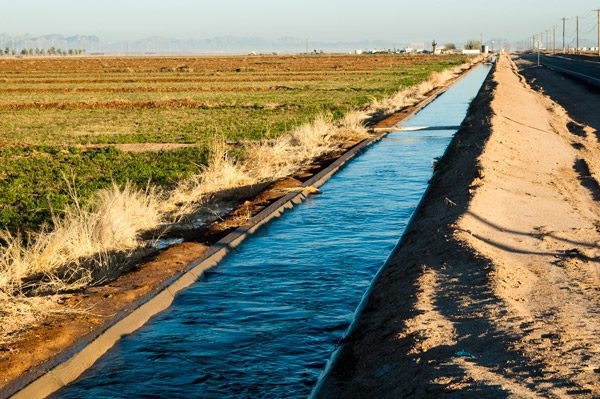- Today’s aging agricultural irrigation systems waste an enormous amount of water and energy.
- Modernizing with readily available/efficient pumps and plastic pipes would dramatically reduce wasted water and energy. And greenhouse gas emissions.
- Tweaks to the U.S. Farm Bill and federal policies could improve sustainability on our farms.
You’ve likely seen the bumper sticker: No Farms, No Food.
True, but in many places, we may be headed to: No Water, No Farms.
Our nation wastes a massive amount of water (see here). Our aging agricultural irrigation systems contribute a lot of that waste.
Imagine the Colorado River flowing through the Grand Canyon. It’s estimated that we lose the equivalent of 2.5X that water flow to evaporation and leakage – every second of every day! Why? In part because we’re actually still using outdated, open canals to transport water for our nation’s agricultural use.
What’s more, data show that these and other inefficient irrigation systems waste 52% of the energy they use.

There’s a better way.
Energy efficiency and access to abundant clean water are key to our nation’s sustainability goals. We can stop wasting so much water and build a more sustainable water infrastructure.
For example, modernizing our irrigation systems with readily available/efficient pumps and plastic pipes would dramatically reduce wasted water and energy. Plus drive down carbon emissions.
The clean energy consulting firm Cadeo looked at savings we could realize from upgrading our irrigation pumps and pipes. You can see the results of their study here, but here are a few mind-blowing figures from the researchers:
- More efficient irrigation systems could save $2.8 billion every year in energy costs.
- Just by replacing existing irrigation pipes with plastic pipes, we’d save 19 million metric tons of carbon during the lifetime of the pipes. That’s equivalent to annual carbon emissions from 2.4 million homes.
- Another amazing stat: Installing turbines in pressurized plastic pipes could actually generate carbon-free electricity – enough to power 1.4 million homes each year!
Smart Public Policy Can Help
Ridding our nation of hundreds of thousands of miles of open canals and corroding metal/concrete pipes obviously requires some significant upfront costs. But this study shows that the return on investment is enormous.
A few important tweaks to the annual Farm Bill could open up funding to equip farmers with efficient plastic piping so they can save money, water and energy and reduce greenhouse gas emissions. And all federally funded programs should encourage use of the most efficient construction materials available – which more often than not includes plastic pipes.
We have high-performance, efficient solutions that can improve sustainability. Let’s use them.
See here for more info on the Cadeo study.
Check out this really cool pipe replacement project at our nation’s Arlington National Cemetery.

